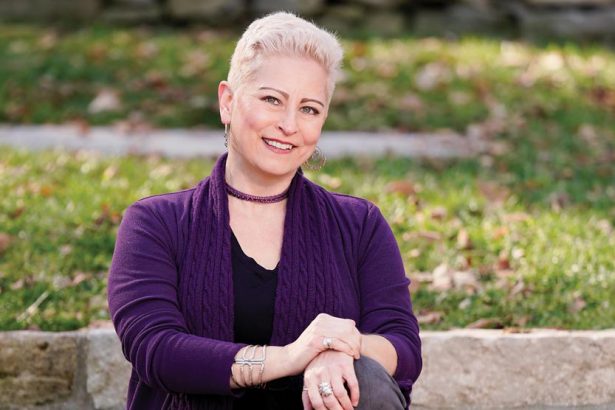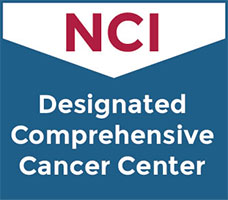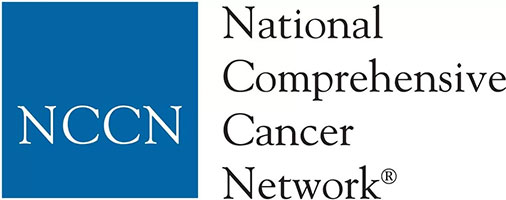Patient Search
 |
 |
|
KaCrole Higgins was diagnosed with breast cancer in 2020. “In May 2020, I found a lump in my breast. I cried. By June, it was diagnosed as breast cancer, triple positive, stage 1A. While getting this cancer diagnosis was devastating, it also became an opportunity. Suddenly, the cancer gave me clarity. It gave me clarity about what was important, what was good in my life, what was toxic in my life, and what I needed to do.” Click below to read more of KaCrole’s story |
If Landon Ryan had been diagnosed with bilateral retinoblastoma 10, 20 or 30 years ago, she might not be here today with nearly perfect vision.Thanks to recent improvements in the treatment for this rare form of cancer that almost exclusively affects children under the age of 5, the diagnosis had the power to change Landon’s life when she was 11 months old, but not to take it — or her eyesight. Click below to learn more about Landon and her story. https://momentum.vicc.org/2022/04/brighter-outlook/ |
Study of Tinengotinib VS. Physician's Choice a Treatment of Subjects With FGFR-altered in Cholangiocarcinoma
Liver
Liver
This study is a Phase III, Randomized, Controlled, Global Multicenter Study to Evaluate the
Efficacy and Safety of Oral Tinengotinib versus Physician's Choice in Subjects with
Fibroblast Growth Factor Receptor (FGFR)-altered, Chemotherapy- and FGFR
Inhibitor-Refractory/Relapsed Cholangiocarcinoma
Efficacy and Safety of Oral Tinengotinib versus Physician's Choice in Subjects with
Fibroblast Growth Factor Receptor (FGFR)-altered, Chemotherapy- and FGFR
Inhibitor-Refractory/Relapsed Cholangiocarcinoma
Liver
III
Heumann, Thatcher
NCT05948475
VICC-DTGIT23271
Circulating Tumor DNA to Guide Changes in Standard of Care Chemotherapy in Patients with Metastatic Triple Negative Breast Cancer
This phase II trial tests how well evaluating circulating tumor deoxyribonucleic acid (ctDNA) works to guide therapy-change decisions in treating patients with triple-negative breast cancer (TNBC) that has spread from where it first started (primary site) to other places in the body (metastatic). This study wants to learn if small pieces of DNA associated with a tumor (called circulating tumor DNA, or ctDNA) can be detected in investigational blood tests during the course of standard chemotherapy treatment for breast cancer, and whether information from such investigational ctDNA blood testing could possibly be used as an early indication of chemotherapy treatment failure. It is hoped that additional information from investigational blood testing for ctDNA could help doctors to switch more quickly from a standard chemotherapy treatment that typically has significant side effects and which may not be working, to a different standard treatment regimen against TNBC, called sacituzumab govitecan. Sacituzumab govitecan is a monoclonal antibody, called hRS7, linked to a chemotherapy drug, called irinotecan. hRS7 is a form of targeted therapy because it attaches to specific molecules (receptors) on the surface of cancer cells, known as TROP2 receptors, and delivers irinotecan to kill them. Studying ctDNA may assist doctors to change therapy earlier if needed, and may improve health outcomes in patients with metastatic TNBC.
Not Available
II
Not Available
NCT05770531
VICCBRE2257
Canakinumab for the Prevention of Progression to Cancer in Patients with Clonal Cytopenias of Unknown Significance, IMPACT Study
Leukemia
Leukemia
This phase II trial tests how well canakinumab works to prevent progression to cancer in patients with clonal cytopenias of unknown significance (CCUS). CCUS is a blood condition defined by a decrease in blood cells. Blood cells are composed of either red blood cells, white blood cells, or platelets. In patients with CCUS, blood counts have been low for a long period of time. Patients with CCUS also have a mutation in one of the genes that are responsible for helping blood cells develop. The combination of genetic mutations and low blood cell counts puts patients with CCUS at a higher risk to develop blood cancers in the future. This transformation from low blood cell counts to cancer may be caused by inflammation in the body. Canakinumab is a monoclonal antibody that may block inflammation in the body by targeting a specific antibody called the anti-human interleukin-1beta (IL-1beta).
Leukemia
II
Kishtagari, Ashwin
NCT05641831
VICC-ITHEM23019
(Z)-Endoxifen for the Treatment of Premenopausal Women With ER+/HER2- Breast Cancer
Breast
Breast
This open-label research study is studying (Z)-endoxifen as a possible treatment for
pre-menopausal (still having periods) women with ER+/HER2- breast cancer. (Z)-endoxifen is a
selective estrogen receptor modulator or "SERM." SERMs work to treat cancer by blocking the
body's natural estrogen from binding to cancer cells. This study includes a pharmacokinetic
part (PK, how the drug works in your body) and a treatment part. The primary purpose of the
study is to see how (Z)-endoxifen works on tumor cell growth by monitoring a cancer marker
called Ki-67. Ki-67 will be measured by biopsy of the breast after about 4 weeks of
treatment. If your cancer is responding to treatment based on the Ki-67 results, you may
continue treatment up to 24 weeks or until surgery.
The PK part of the study will be enrolled first, enrolling about 18 study participants who
will all receive oral once daily (Z)-endoxifen treatment. 12 of these participants will be
randomly assigned to treatment with an equal (50/50) chance to be assigned to (Z)-endoxifen
or (Z)-endoxifen + goserelin (a medication given to block the ovaries from making estrogen
and is also called ovarian suppression). This part of the study will help select the dose of
(Z)-endoxifen to use in the treatment part by measuring the levels of (Z)-endoxifen in the
blood stream and determine how long it takes for the body to remove it.
About 160 study participants will be enrolled in the treatment part. The treatment part will
help to determine how oral once daily (Z)-endoxifen, when taken by itself, compares to oral
once daily exemestane (a medication that decreases the amount of estrogen in the body, also
known as an aromatase inhibitor) and monthly injections of goserelin. Exemestane and
goserelin taken together is a standard treatment regimen for premenopausal patients with
ER+/HER2- breast cancer. Study participants are randomly assigned to treatment with an equal
(50/50) chance to be assigned to (Z)-endoxifen or standard treatment.
Study participation is up to 24 weeks of treatment followed by surgery.
pre-menopausal (still having periods) women with ER+/HER2- breast cancer. (Z)-endoxifen is a
selective estrogen receptor modulator or "SERM." SERMs work to treat cancer by blocking the
body's natural estrogen from binding to cancer cells. This study includes a pharmacokinetic
part (PK, how the drug works in your body) and a treatment part. The primary purpose of the
study is to see how (Z)-endoxifen works on tumor cell growth by monitoring a cancer marker
called Ki-67. Ki-67 will be measured by biopsy of the breast after about 4 weeks of
treatment. If your cancer is responding to treatment based on the Ki-67 results, you may
continue treatment up to 24 weeks or until surgery.
The PK part of the study will be enrolled first, enrolling about 18 study participants who
will all receive oral once daily (Z)-endoxifen treatment. 12 of these participants will be
randomly assigned to treatment with an equal (50/50) chance to be assigned to (Z)-endoxifen
or (Z)-endoxifen + goserelin (a medication given to block the ovaries from making estrogen
and is also called ovarian suppression). This part of the study will help select the dose of
(Z)-endoxifen to use in the treatment part by measuring the levels of (Z)-endoxifen in the
blood stream and determine how long it takes for the body to remove it.
About 160 study participants will be enrolled in the treatment part. The treatment part will
help to determine how oral once daily (Z)-endoxifen, when taken by itself, compares to oral
once daily exemestane (a medication that decreases the amount of estrogen in the body, also
known as an aromatase inhibitor) and monthly injections of goserelin. Exemestane and
goserelin taken together is a standard treatment regimen for premenopausal patients with
ER+/HER2- breast cancer. Study participants are randomly assigned to treatment with an equal
(50/50) chance to be assigned to (Z)-endoxifen or standard treatment.
Study participation is up to 24 weeks of treatment followed by surgery.
Breast
II
Abramson, Vandana
NCT05607004
VICCBRE22108
Capecitabine Compared to Endocrine Therapy for the Treatment of Non-luminal A Hormone Receptor-Positive Metastatic Breast Cancer
Breast
Breast
This phase II trial compares the effect of capecitabine to endocrine therapy in patients with non-Luminal A hormone receptor-positive breast cancer that has spread from where it first started (primary site) to other places in the body (metastatic). In this study, patients submit a sample of tumor for testing to determine if their breast cancer is considered non-Luminal A. Only patients with non-Luminal A receive study treatment. In the future, doctors hope that this test can assist in picking the best treatment for patients with this type of cancer. Capecitabine is in a class of medications called antimetabolites. It is taken up by tumor cells and breaks down into fluorouracil, a substance that kills tumor cells. Endocrine therapy is treatment that adds, blocks, or removes hormones. To slow or stop the growth of certain cancers (such as prostate and breast cancer), synthetic hormones or other drugs may be given to block the body's natural hormones. Giving capecitabine as compared to endocrine therapy may kill more tumor cells in patients with metastatic breast cancer.
Breast
II
Reid, Sonya
NCT05693766
VICCBRE2256
Hypofractionated Radiotherapy followed by Surgery for the Treatment of Soft Tissue Sarcomas
Sarcoma
Sarcoma
This phase II trial studies the effect of hypofractionated radiotherapy followed by surgery in treating patients with soft tissue sarcoma. Hypofractionated radiation therapy delivers higher doses of radiation therapy over a shorter period of time and may kill more tumor cells and have fewer side effects. Giving hypofractionated radiotherapy followed by surgery may allow patients with sarcomas to be treated in a much more rapid and convenient fashion.
Sarcoma
II
Shinohara, Eric
NCT04506008
VICCSAR2062
Study of SRF114 in Patients With Advanced Solid Tumors
Head/Neck
Head/Neck
This is a Phase 1/2, open-label, first-in-human, dose-escalation and expansion study of
SRF114, a monoclonal antibody that targets CCR8, as a monotherapy in patients with solid
tumors.
SRF114, a monoclonal antibody that targets CCR8, as a monotherapy in patients with solid
tumors.
Head/Neck
I
Choe, Jennifer
NCT05635643
VICC-DTHAN23184P
Total Body Irradiation and Hypofractionated Radiation Therapy with Atezolizumab and Chemotherapy for the Treatment of Extensive-Stage Small Cell Lung Cancer, TESSERACT Trial
Multiple Cancer Types
This phase I/II trial studies the side effects, safety, and effectiveness of low dose radiation to the entire body (total body irradiation [TBI]) and higher dose radiation to known areas of cancer (hypofractionated radiation therapy [H-RT]) combined with atezolizumab and chemotherapy (carboplatin & etoposide) in treating patients with small cell lung cancer that has spread to disease sites outside of the lung (extensive stage). Extensive stage disease has historically been treated with chemotherapy alone with consideration of chest (thoracic) radiation therapy for those with response to chemotherapy, as well as consideration of preventative radiation therapy to the head (prophylactic cranial irradiation). Emerging evidence supports the synergistic interactions between immunotherapy and radiation therapy. Immunotherapy with monoclonal antibodies, such as atezolizumab, may help the body's immune system attack the cancer, and may interfere with the ability of tumor cells to grow and spread. Carboplatin is in a class of medications known as platinum-containing compounds. It works in a way similar to the anticancer drug cisplatin, but may be better tolerated than cisplatin. Carboplatin works by killing, stopping or slowing the growth of tumor cells. Etoposide is in a class of medications known as podophyllotoxin derivatives. It blocks a certain enzyme needed for cell division and DNA repair and may kill tumor cells. Combining TBI and H-RT with atezolizumab and chemotherapy may improve response to treatment.
Lung,
Small Cell
I/II
Osmundson, Evan
NCT06110572
VICCTHOP2206
Split Course Adaptive Radiation Therapy and Immunotherapy with or without Chemotherapy for the Treatment of Stage IV or Locally Advanced Lung Cancer, SiCARIO Study
Multiple Cancer Types
This phase I/II trial tests the safety and efficacy of split-course adaptive radiation therapy in combination with immunotherapy with or without chemotherapy for the treatment of patients with stage IV lung cancer or lung cancer that that has spread to nearby tissue or lymph nodes (locally advanced). Radiation therapy is a standard cancer treatment that uses high energy rays to kill cancer cells and shrink tumors. Split-course adaptive radiation therapy uses patient disease response to alter the intensity of the radiation therapy. Immunotherapy with monoclonal antibodies such as pembrolizumab, ipilimumab or nivolumab may help the body's immune system attack the cancer, and may interfere with the ability of tumor cells to grow and spread. Chemotherapy drugs like carboplatin, pemetrexed, and paclitaxel work in different ways to stop the growth of cancer cells, either by killing the cells, by stopping them from dividing, or by stopping them from spreading. Giving split-course adaptive radiation therapy with standard treatments like immunotherapy and chemotherapy may be more effective at treating stage IV or locally advanced lung cancer than giving them alone.
Lung,
Non Small Cell,
Phase I
I/II
Osmundson, Evan
NCT05501665
VICCTHOP2185
Gabapentin plus Ketamine for the Prevention of Acute and Chronic Pain in Patients with Locally Advanced Head and Neck Cancer Undergoing Chemoradiation
Multiple Cancer Types
This phase I/II trial studies the side effects and best dose of a combination of gabapentin and ketamine and to see how well it works to prevent acute and chronic pain in patients receiving chemotherapy and radiation therapy (chemoradiation) for head and neck cancer that has spread to nearby tissue or lymph nodes (locally advanced). Gabapentin is a medication that is commonly used to treat nerve related pain. Specifically, it has been used to treat pain involving the mouth, throat and nasal passages in head and neck cancer patients treated with radiation. Ketamine is a type of general anesthetic that blocks pathways to the brain involved with sensing pain. This trial may help doctors determine how patients tolerate the combination of gabapentin and ketamine and to find the correct dosing for ketamine in those taking gabapentin. This will be the basis for a future, larger study to look at how effective this combination is at reducing and/or preventing pain in head and neck cancer patients.
Head/Neck,
Phase I
I/II
Lockney, Natalie
NCT05156060
VICCHNP2173


